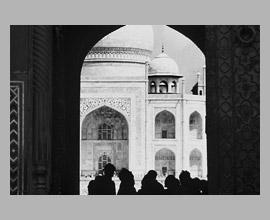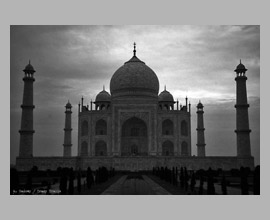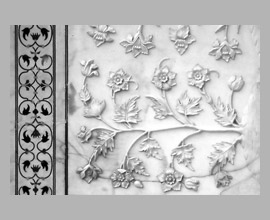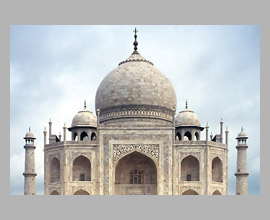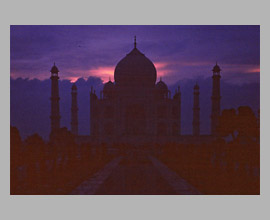The Taj Mahal is an ivory-white marble mausoleum on the south bank of the Yamuna River, in the Indian city of Agra. It was commissioned in 1632 by the Mughal emperor, Shah Jahan (reigned 1628–58), to house the tomb of his favourite wife, Mumtaz Mahal; it also houses the tomb of Shah Jahan himself. The tomb is the centre-piece of a 17-hectare complex, which includes a mosque and a guest house, and is set in formal gardens surrounded on three sides by a crenellated wall.
The Taj Mahal is a symbol of love and devotion. It is a testament to the love that Shah Jahan had for his wife, Mumtaz Mahal. It is widely recognized as "the jewel of Muslim art in India” and one of the universally admired masterpieces in the world. It is one of the most visited tourist destinations in India, and is a UNESCO World Heritage Site.
The history of the Taj Mahal begins with the love story of Shah Jahan and Mumtaz Mahal. The couple was married in 1612 and had 14 children together. Mumtaz Mahal died in childbirth in 1631, at the age of 38. Shah Jahan was devastated by her death and vowed to build a mausoleum in her memory that would be the “envy of the world".
The construction of the Taj Mahal began in 1632 and took 22 years to complete. Over 20,000 workers were employed on the project, including; architects, masons, sculptors, and calligraphers. The marble used for the mausoleum was brought from Rajasthan, and the precious stones were imported from all over the world.
The Taj Mahal is a masterpiece of Mughal architecture. It is a blend of Indian, Persian, and Islamic styles. The mausoleum is made of white marble and is decorated with intricate carvings and verses from the Quran. It is surrounded by formal gardens, which are divided by a reflecting pool, which is said to symbolize the tears of Shah Jahan for his wife. The gardens are planted with flowers, trees, and fountains. They were designed to create a sense of peace and tranquility.
Here are some interesting facts about the Taj Mahal:
- The white marble used in construction was so pure that it had to be transported at night to prevent it from being stained by the sun.
- The mausoleum is decorated with over 1,000 precious stones, including lapis lazuli, jade, crystal, turquoise, and amethyst.
- The dome of the mausoleum is a perfect sphere, and the four minarets at each corner are perfectly aligned.
The Taj Mahal is a truly remarkable building, and it's no surprise that it is considered to be one of the wonders of the world. It's a must for any visit to India but I suggest avoiding free entry days (half of the country shows up, lol).
Andrzej


